Current Events :












Jalandhar, December 26
The last rites of Lieut Col Karanbir Singh Natt, who passed away on Sunday after remaining comatose for eight years, were held at Ram Bagh cremation ground, near Jalandhar Cantonment, here today.
Veteran Army officials, including Lieut Gen JS Dhillon, serving defence personnel and staff from the civil administration attended the last rites held with military honours. Martyr’s elder daughter Guneet Kaur lit the pyre. Former minister Tript Rajinder met Lieut Col Natt’s father Col Jagtar Singh Natt and wife Navpreet Kaur and expressed his condolences to the bereaved family.

Col Jagtar Singh Natt said, “I am a proud father. My son was not only a selfless Army man, but also a devout Sikh who would not have his breakfast before his morning routine of reciting Gurbani. His 160 TA unit had Muslims in majority with whom he also used to celebrate Eid. When I visited him in a Delhi hospital after he suffered injuries, his mobile phone was handed over to me. The status that he had posted on WhatsApp on that day in November 2015 read: ‘I do not know how my spirit will end, but no one will say I gave up’.”
Lieut Col Karanbir Singh Natt was injured in a counter-insurgency operation in Kupwara, Jammu & Kashmir. A militant holed up in an abandoned hut had fired at him and a bullet had smashed his lower jaw.
He went into coma and remained hospitalised for eight years in the Army hospitals at New Delhi and Jalandhar.

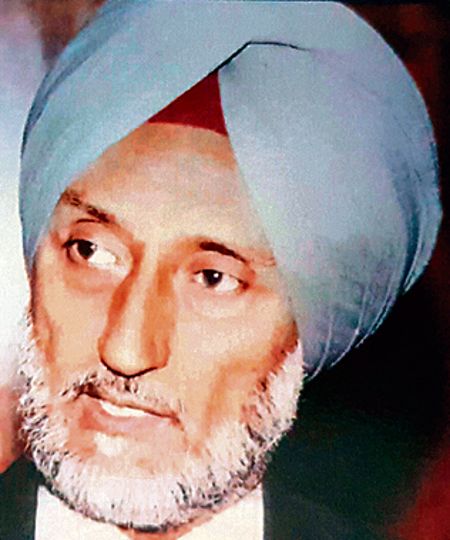
HELLO, Victor 15, Gumri captured, enemy on the run, over.” This was the crisp radio message sent at 1500 hours (3 pm) on November 1, 1948, by Capt SDS Jamwal, Commander, C Squadron, 7 Light Cavalry. With just two years of commissioned service and in the manner of the 1854 ‘Charge of the Light Brigade’, Capt Jamwal had led the attack — unmindful of the odds — for the capture of Zoji La. The order for the commencement of the attack had been given to him by Maj Gen KS Thimayya at 10:15 am in the assembly area, which was about 1 km short of the pass but hidden from the view of the usurpers of Zoji La.
The presence of C Squadron in the valley had remained such a well-guarded secret that when the Stuart tanks zeroed in on Pakistani bunkers with the full force of their guns, Pakistan General Headquarters’ retort to their panicked soldiers was: “Don’t be stupid… I know those roads and bridges… no tanks can cross them. Those bloody things are probably jeeps made to look like tanks…” This vindicated Maj Gen Thimayya’s gamble born out of astute professionalism. The kinetic lethality and the tanks’ presence were so overwhelming that the follow-up combat by the infantry was ‘no big deal’.
When General Thimayya, a World War II veteran, “along with his buddy, Naik Ram Singh, walked up to our location”, about 5 km beyond Zoji La in Gumri Basin (the size of about three mega cricket fields), it was a fairly “cool joint”! But on C Squadron’s insistence, the GOC was sent back in a T16 carrier. As night temperature plummeted to minus 30-40°C, “there was one dry root of a big tree next to the Gumri rest house… drained some fuel from one tank… set the root on fire… sat through the longest night of the year!… on November 2, all commanders in the chain from Lt Gen KM Cariappa… Brig KL Atal arrived… and greeted us for the successful operation…”
The formal message from Corps Commander Lt Gen SM Shrinagesh read: “By our capture of Machoi, the enemy defences at Zoji La have been broken and he (enemy) is now fleeing towards Kargil, the magnificent part played by C Squadron… will always be remembered as the greatest achievement by tanks…. Please convey to Capt Sharak Dev Singh Jamwal, Commander, C Sqn, my warmest congratulations for his dash and boldness… the JCOs and OR… have won our admiration. Well done.”
These excerpts are from a 13-page narrative composed in 1999 by Lt Col Jamwal (retd) “to set the record straight” and reproduced in the 2022 book Treachery & Gallantry; Gilgit-Skardu-Ladakh 1947-48 by Col Ajay K Raina and Brig Rajendra Singh. The nonagenarian veteran was interviewed by the authors, and he amazed them by his “razor-sharp memory; uses no glasses or any other aid….”
On assuming command of Sri Division (present 19 Division) on May 3, 1948, Gen Thimayya had emphasised to his commanders and staff that “… the fall of Leh will be a strategic blow to India. It has to be saved at all costs…”, which also set the stage to attempt the first landing of a Dakota aircraft by Air Commodore Mehar Singh with Maj Gen Thimayya on board on May 24, 1948, at a rudimentary mud strip on the outskirts of Leh. The man behind the design and construction of the 2,300-yard airstrip, solely through manual labour, was Sonam Norbu (Leh-born but trained in civil engineering in London, courtesy Maharaja Hari Singh). When the first company of 2/4 GR (Gorkha Rifles) landed, the “Ladakhis were waiting with baskets full of grass that they wanted to feed the flying iron horses”, as narrated by Sonam to a friend.
However, the euphoria was shortlived as meteorological turbulence precluded reinforcements to Leh by air in the near future. Desperate situations demand courageous leadership and for a start Lt Gen Cariappa ordered 2/8 GR Battalion, based at Ferozepore, to despatch forthwith one rifle company to Leh via Manali. Lt Col HS Parab rose to the challenge manfully. Maj Hari Chand-led D Company (nicknamed ‘Arjun Column’) boarded a train for Pathankot on May 24, 1948, and commandeered local buses to Manali. Employing local guides subsequently, the column began a ‘forced march’ of 427 km, sans specialised clothing, and arrived at Leh on July 7, 1948.
The enemy, meanwhile, had arrived at Nimu, about 35 km from Leh, depriving Arjun Column much-deserved rest. Maj Hari Chand set about creating a mixed platoon of Gorkha and Leh militia, which went on to earn the ‘Ghost of Himalayas’ sobriquet and got him the Maha Vir Chakra.
The area from Gilgit to Skardu and Kargil to Nimo was still under enemy occupation. So, the remainder of the 2/8 battalion was also ordered to Leh. A Company (with Lt Col Parab) was airlifted from Srinagar to Leh, while B and C companies, carrying 600 extra rifles and 60,000 rounds of ammunition, were waved off from Manali on August 24, 1948, on another epic ‘forced march’, reaching Leh on September 18.
Lt Col Jamwal (retd), now 97, is probably the sole survivor from that mighty phalanx which brought the India-Pakistan war of 1947-48 to a conclusion. He deserves appropriate recognition at the national level.
Postscript: When Maj Gen Thimayya landed at Srinagar on May 3, 1948, to assume command of Sri Division, accompanying him was a filmmaker, Serbjeet Singh, who filmed the capture of Zoji La and made a documentary, Liberation of Ladakh.
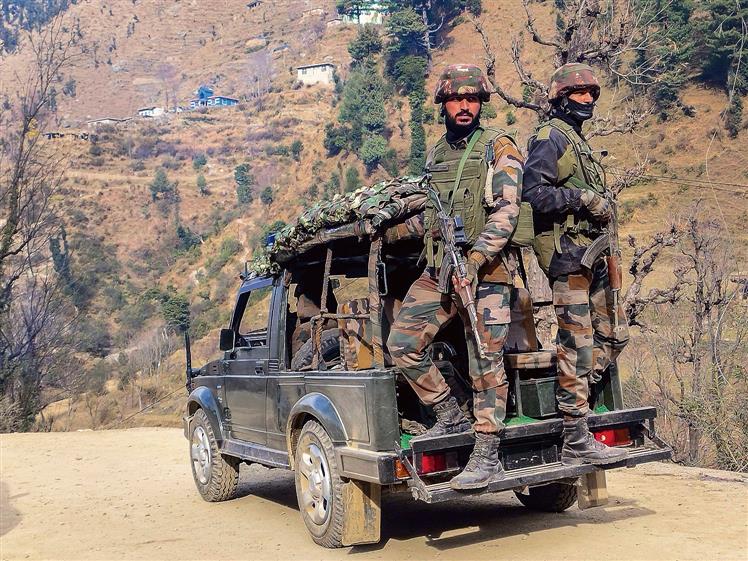
Arjun Sharma
Jammu, December 26
With an increase in terror activities in Rajouri and Poonch, the Army is set to increase its presence in both districts which have witnessed multiple terror attacks in the recent past.
The decision comes in the wake of December 21 ambush of two Army vehicles by ultras in which four soldiers were killed in Surankote of Poonch.
The area is heavily forested and it has become difficult for the security forces to search for the terrorists behind the act as they are hiding in the woods.
Sources in the Army Intelligence said the increase in the presence of troops was discussed during the visit of Army Chief General Manoj Pande. “The increase will be temporary as of now so that forest areas in entire region are searched for natural hideouts, including caves, where these terrorists hide after attacking the security forces,” a source said.
The Pir Panjal range comprising of Rajouri and Poonch district is known for its tough topography and natural caves. Terrorists have been known to use these caves as their hideouts.
These caves are difficult to locate and are present in abundance in the forest areas. The Army chief had discussed the possibility of finding and destroying these caves during his meeting with commanders during a visit to Poonch on Monday.
The police have also been asked by higher authorities to act against those providing shelter and food to the terrorists in the region. The police have already started a drive in which terror associates are being identified in villages of the two districts.
Meanwhile, the security forces have found a unique pattern in different encounters, especially in Rajouri and Poonch districts, where terrorists are found to be operating in group of two members. Sources say that after infiltration from Pakistan, terrorists find it easy to hide in small groups. There are at least 25-30 ultras present in the jungles of Rajouri and Poonch that have emerged as the new terror hotspot in J&K.
There have been multiple encounters between security forces and trained armed terrorists in the twin districts along Line of Control during the last one year. However, it is believed that the recent ambush in which four Army soldiers were killed in Surankote of Poonch was handiwork of at least two pairs or of four trained ultras.
“Operating in pair of two also indicate that these terrorists are highly trained by the Pakistan Army and are able to sustain on their own for months. It is certain that Over Ground Workers (OGWs) are helping these terrorists by providing food and other necessary items,” a source said.
Two OGWs, including Nisar Ahmed and Mushtaq Ahmed, were arrested in connection with ambush on an Army truck near Bhimber Gali of Poonch, in which five soldiers were killed on April 20. The OGWs had constructed hideouts for terrorists near their homes where arms, ammunition and even cigarettes were kept.
Aim to locate, destroy hideouts of militants
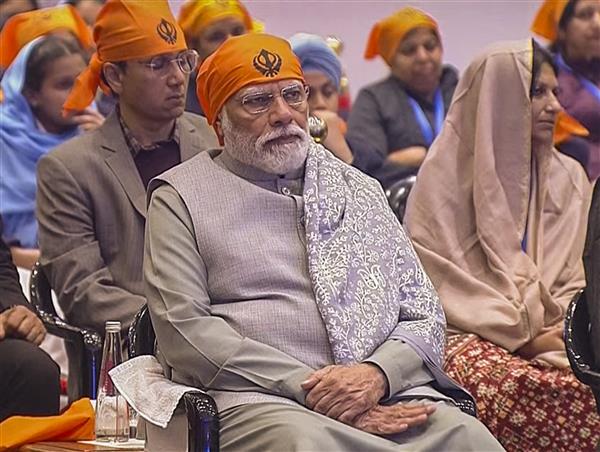
New Delhi, December 26
Prime Minister Narendra Modi said on Tuesday that the Sikh gurus had taught Indians to live for the glory of their land and served as an inspiration to make the country better and developed.
Speaking at a Veer Bal Diwas event to commemorate the martyrdom of two sons of Guru Gobind Singh, Modi said India is now coming out of the “mindset of slavery” and had full faith in its people, their abilities and heritage.
“When we did not respect our heritage, the world also did not value it,” he said, adding that the global view had now changed. When the country moves forward with pride in its heritage, the world also respects it, Modi said.
In his address, the prime minister said the sacrifices of Guru Gobind Singh’s sons Zorawar Singh and Fateh Singh, who were executed by the Mughals, are not only being remembered in India but also globally through programmes in countries like the United States, Australia, New Zealand, the United Arab Emirates and Greece.
Modi said his government had a clear vision and roadmap to fulfil the unlimited dreams of India’s youngsters, irrespective of the region and society they were born in. The next 25 years would bring a lot of opportunities for youngsters, he said.
The government had a clear policy and no flaw in its intentions, Modi said, citing the increase in the size of the Indian economy.
The world is looking at India as a land of opportunities today and the country is playing a big role in resolving global challenges, he added.
India is standing proudly in every field, be it economy, science, research, sports or strategy, the prime minister asserted.
India has a larger population of young people today compared to the days of the freedom struggle and it is beyond imagination as to how far the country can advance now, he said.
It is for the youngsters to decide what shape would a developed India take in 2047, the prime minister said, adding that the government is always standing with them like a friend.
“We do not have to waste a single moment,” he said.
The prime minister exhorted youngsters to give top priority to their health, saying when they are fit, they will be “super hit” in their careers and life. He asked them to stick to a good diet, opt for digital detoxification and shun the use of narcotics.
Modi appealed to religious leaders and social organisations to launch a movement against drugs.
Veer Bal Diwas is a symbol of the resolve to do anything to protect Indian-ness, the prime minister said in his tributes to the two Sahibzadas.

Panaji, December 26
A fighter aircraft of the Indian Navy suffered a tyre burst on the taxiway at the Dabolim airport in Goa on Tuesday afternoon, just before it was to undertake a routine sortie, officials said.
Due to the tyre burst, the aircraft, MiG-29K, got stranded on the taxiway, but nobody was injured. As a result of the incident, the authorities shut the airport’s runway for operations till 4 pm, affecting the services of passenger flights, they said.
“When the aircraft was on the taxiway ahead of its routine sortie, it suffered a tyre burst. Immediately after that, the fire brigade and other services were pressed into action,” a navy spokesperson said.
The single-pilot aircraft will be moved away from the taxiway, he said.
The official did not specify the time of the incident.
The Dabolim airport, located in South Goa district, is part of the naval base INS Hansa. The facility is used by naval aircraft during certain time of the day.
“As a result of the incident, the airport runway has been shut for operations till 4 pm. The services of 10 flights were affected. Some flights were diverted to the Manohar International Airport at Mopa,” Dabolim airport’s director S V T Dhanamjaya said.
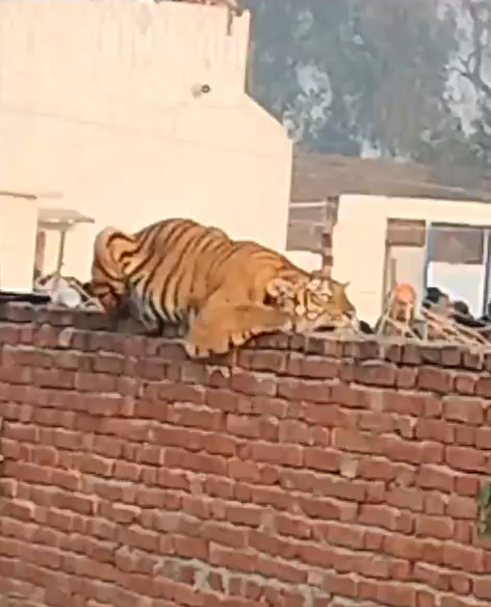
Chandigarh, December 26
A tiger that strayed from a forest area into the human habitation and landed on a wall of a gurdwara in UP’s Pilibhit has become a centre of attraction for the locals.
People have gathered in large numbers to witness the animal at Atkona village that had come out of the nearby tiger reserve forest.
To ensure people’s safety, the Forest Department has created a security cordon using a net.
Police have also reached the spot.
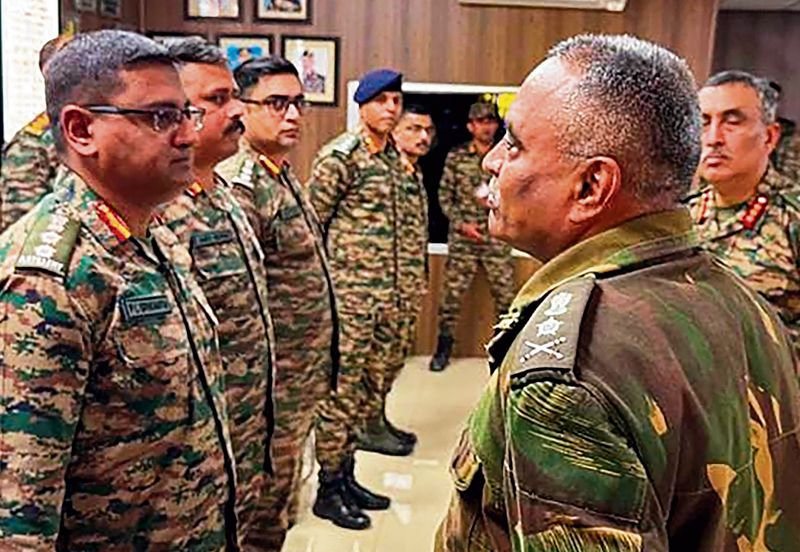
Arjun Sharma
Jammu, December 25
Army Chief General Manoj Pande visited Jammu and Kashmir on Monday and exhorted commanders to conduct operations in the “most professional manner” amid an outrage over the alleged killing of three civilians picked up by the force for questioning following a terrorist attack in Poonch last week that left four soldiers dead.
Editorial: J&K civilian deaths
The Chief of Army Staff (COAS), who visited the ground zero in Poonch-Rajouri sector where a massive anti-terrorism operation is underway, also asked the troops to remain resolute and steadfast against all challenges.
‘Focus on tech use for search in dense forest’
In a related development, the Army initiated a Court of Inquiry as the police lodged a murder case (under Section 302 of the IPC) against unnamed persons over the death of the three civilians, sources said. The three civilians, aged between 27 and 42, were picked up by the Army for questioning after the terrorist ambushed two Army vehicles on Thursday at Dhatyar Morh between Dhera Ki Gali and Baffliaz in Surankote, Poonch. The three were found dead on December 22.
General Pande’s visit holds importance as there has been anger among locals over the alleged custodial deaths. Sending out a strong message that it has taken a serious note of the death of the three civilians, the Army has also replaced some senior officers in the region after a purported video of the civilians’ interrogation went viral. An Army spokesperson said, “General Manoj Pande visited the Poonch sector and was given an update on the prevalent security situation.” Lt General Upendra Dwivedi, General Officer Commanding-in-Chief (GOC-in-C), Northern Command, and Lt General Sandeep Jain, GOC of Nagrota-based White Knight Corps, were among those present during the visit.
It has been reliably learnt that the Army Chief laid stress on intelligence-sharing with other agencies and coordination with the J&K Police. He also asked commanders to focus on the use of technology during search operation in dense forest areas. He asked the officers to ensure that the killers of four soldiers do not escape.
Intense combing operations are underway in the twin districts of Rajouri and Poonch after four soldiers were ambushed in Surankote. The bodies of two soldiers were reportedly mutilated.
The mobile Internet services in both districts remained suspended for the third day on Monday. The militants are suspected to have access to the Internet as they shared the photos of the attack, captured from body cameras, on social media.
Meanwhile, Mohd Sadiq, a relative of one of the deceased civilians, said the three men were picked up by the troops accompanied by policemen Mohd Rafiq and Mohd Rashid along with their sources Jagi and Ganesh in the full public gaze. He sought inclusion of the concerned Army major, policemen and the Army sources in the FIR.
Combing operation on for five days
General Manoj Pande reviewed the anti-terrorist operation going on in Surankote, Poonch, and nearby Rajouri district’s Thanamandi forest belt for the last five days to neutralise the terrorists behind the dastardly attack on December 21
(With inputs)

Chandigarh, December 26
Daughter Guneet Kaur lit the pyre of father Lt Col Karanbir Singh Natt in Jalandhar on Monday.
Lt Col Singh died on Saturday after being in coma for eight years.
Lt Col Karanbir Singh, a Sena medal winner, had been in coma after being injured in an encounter with the terrorists in Kupwara district of Jammu and Kashmir in 2015.
For all these years, his family, including his father Col Jagtar Singh Natt, wife Navpreet Kaur and daughters Guneet and Ashmeet (aged 19 and 10) had been taking turns attending to him in room number 13 of the Officers’ Ward at the Military Hospital.
Lt Col Natt had joined the Short Service Commission in the Guards Regiment in 1998. In 2012, he was relieved after completing 14 years of service. He did LLB and MBA and took up a civil job. But he insisted on going back to the armed forces and joined the 160 TA unit.

























































